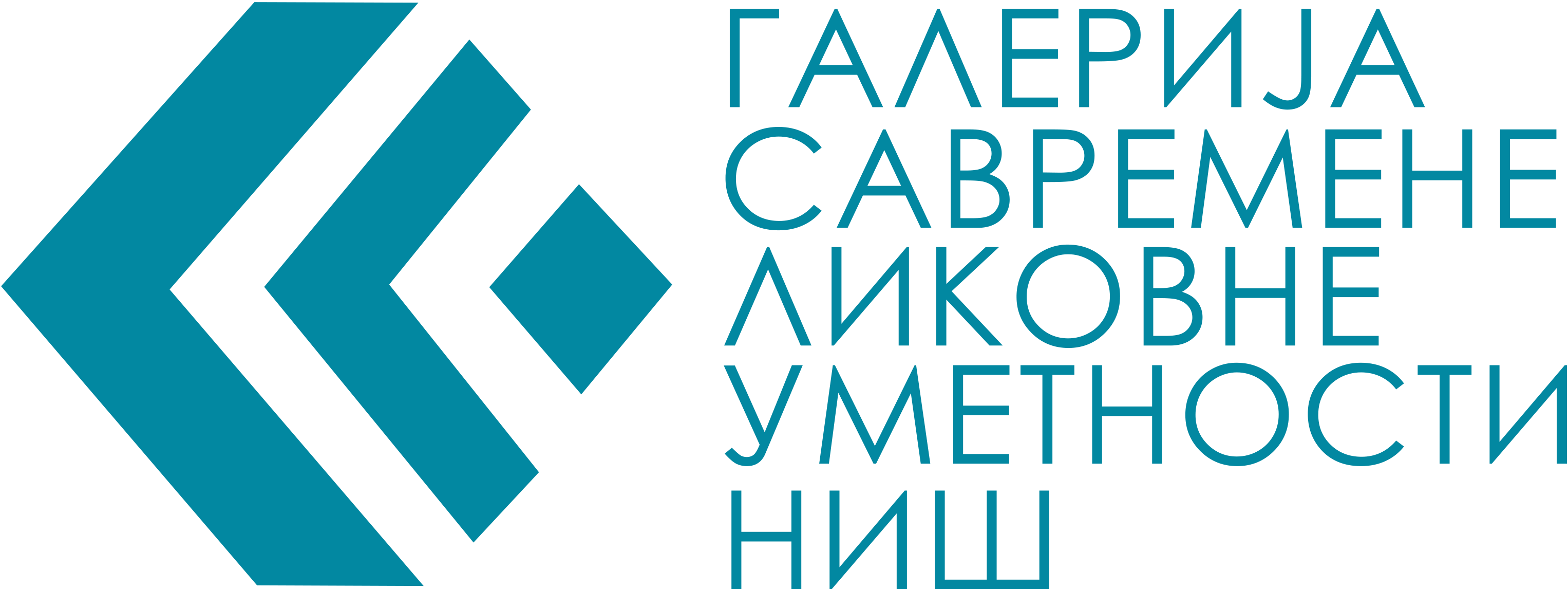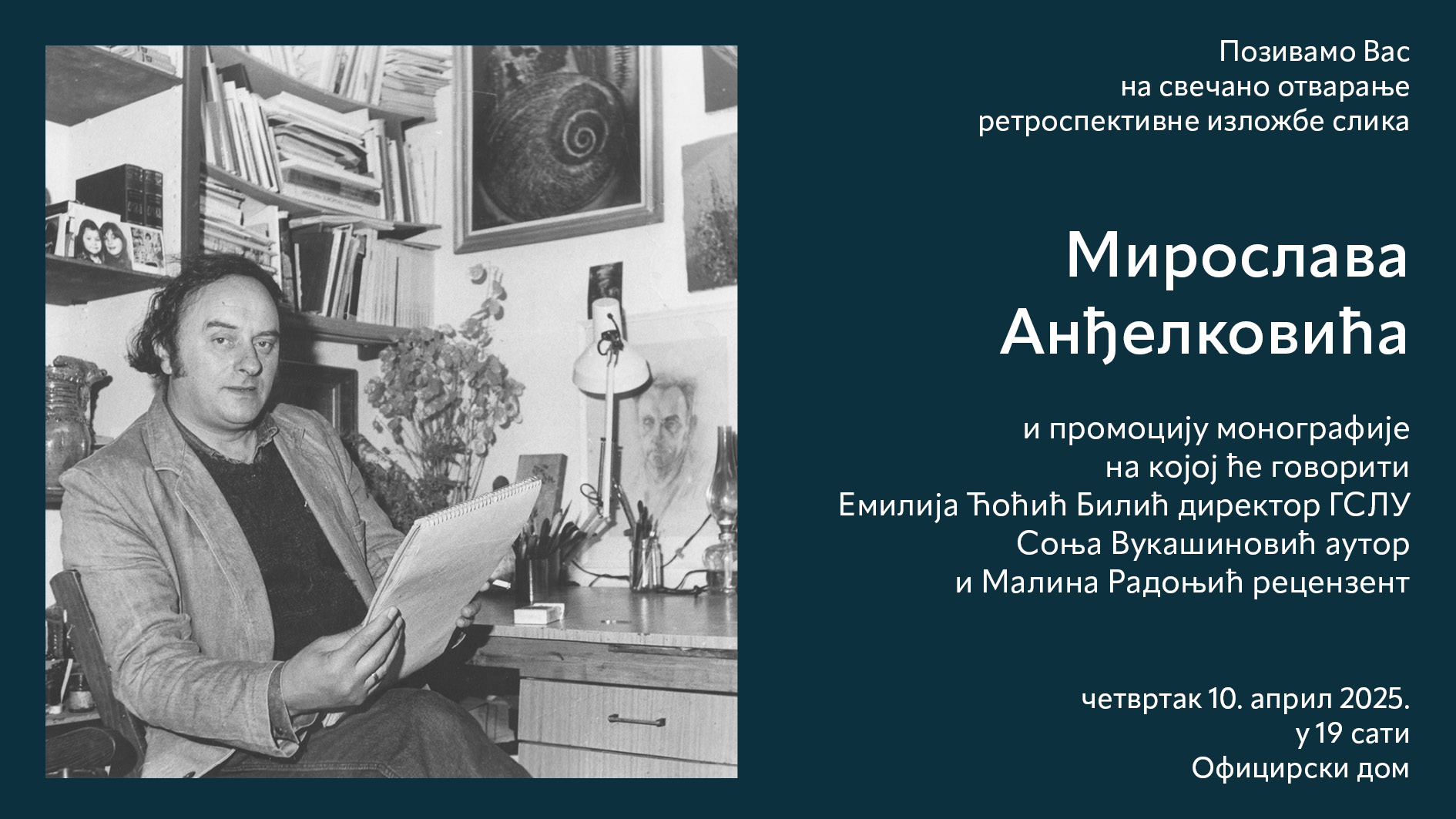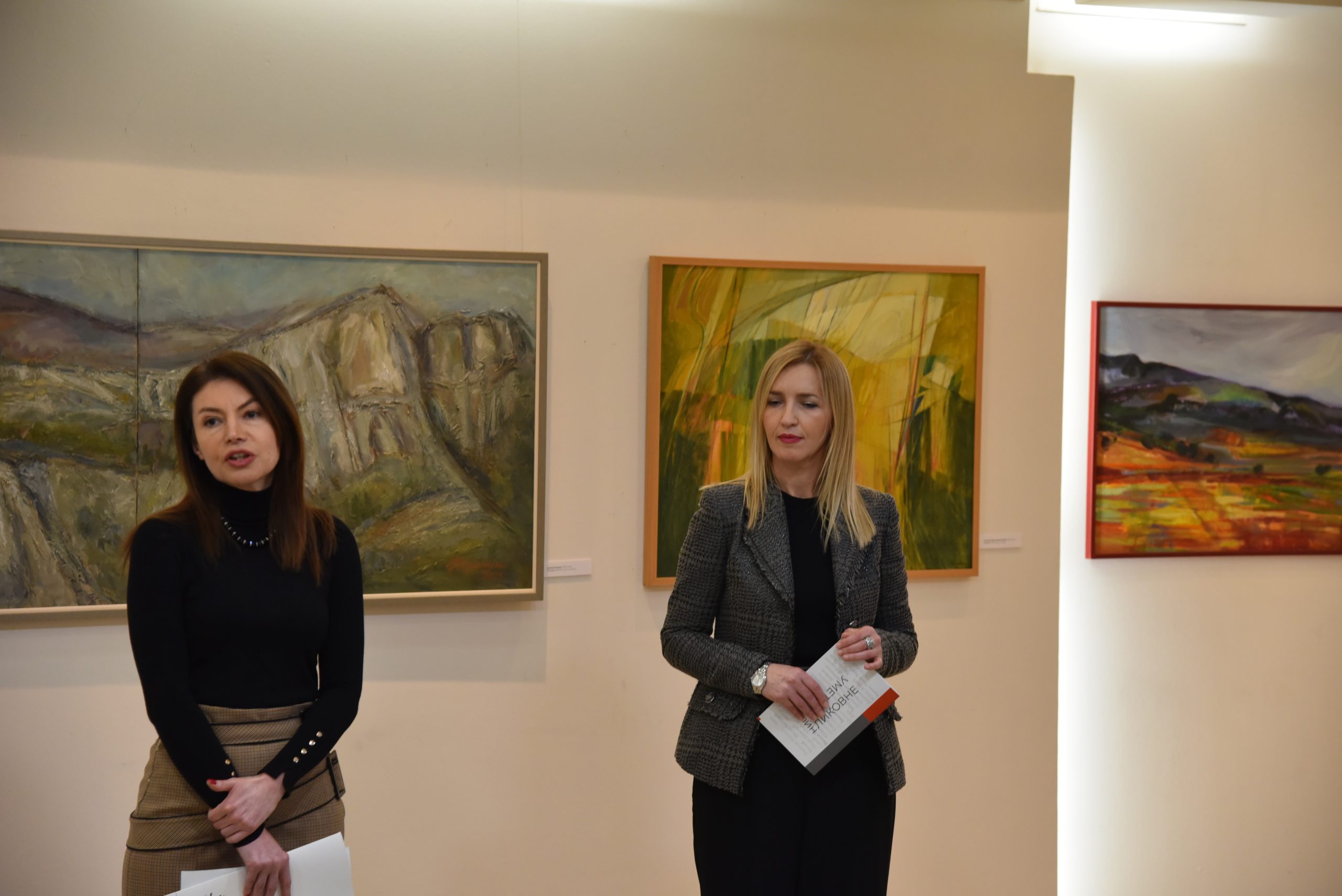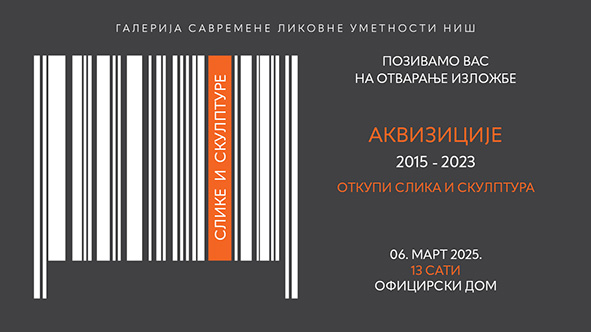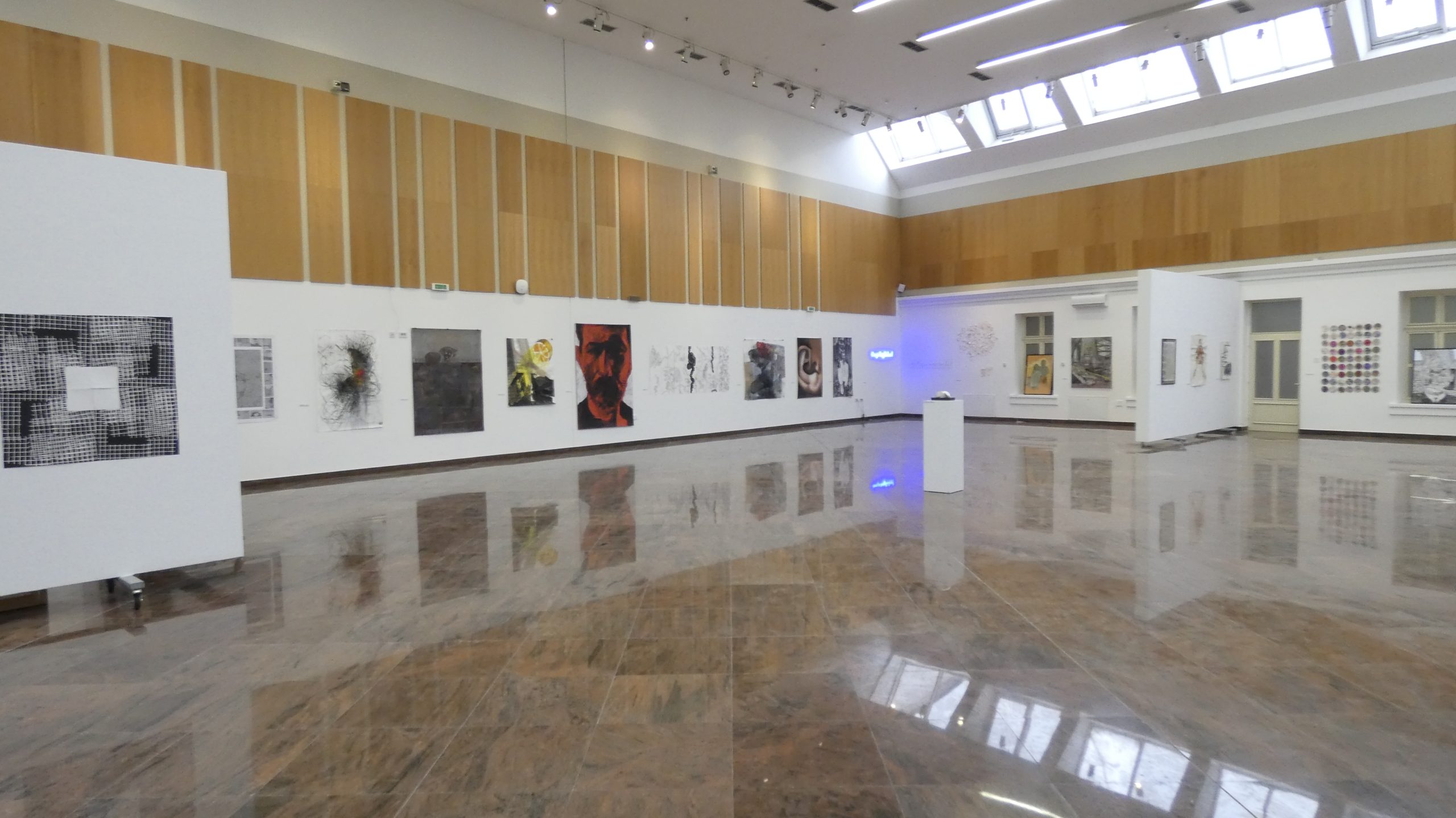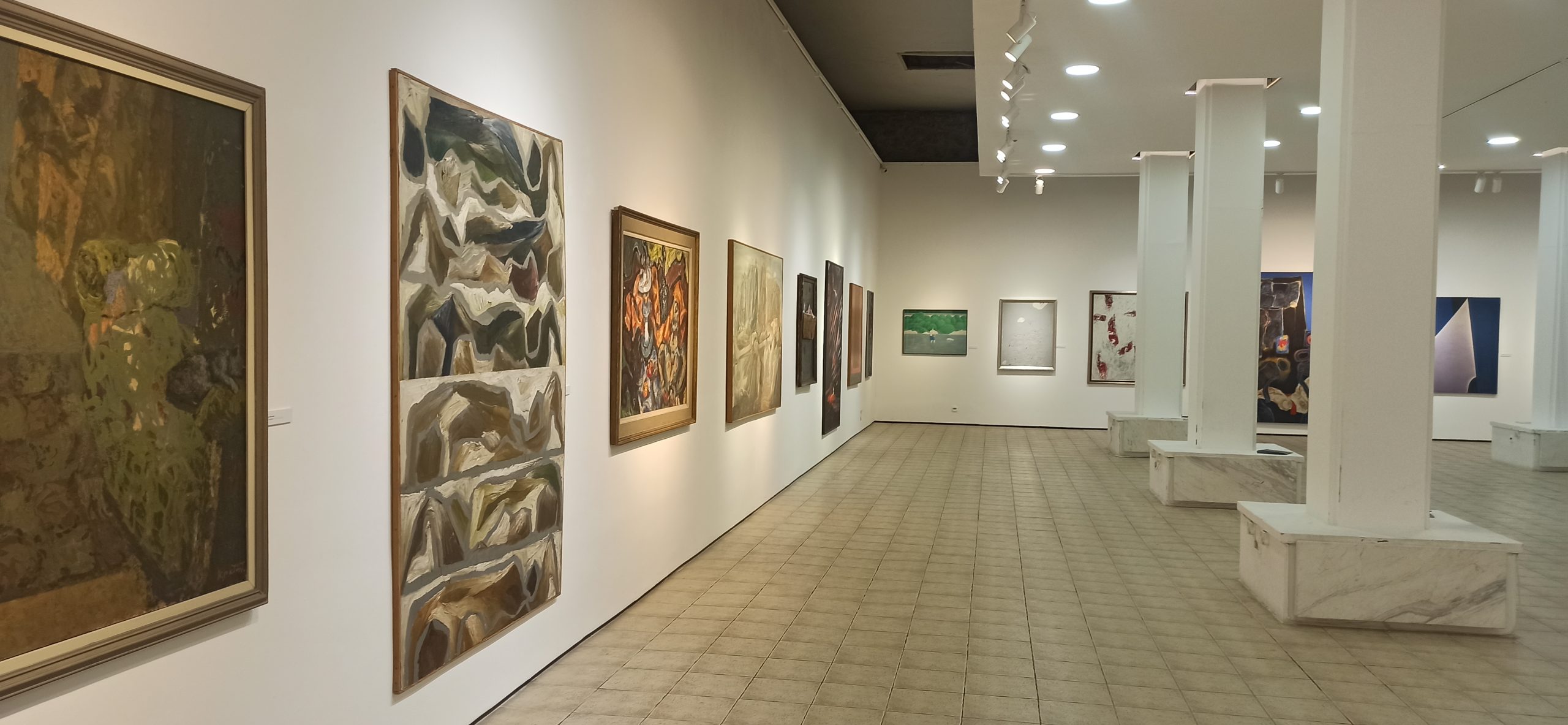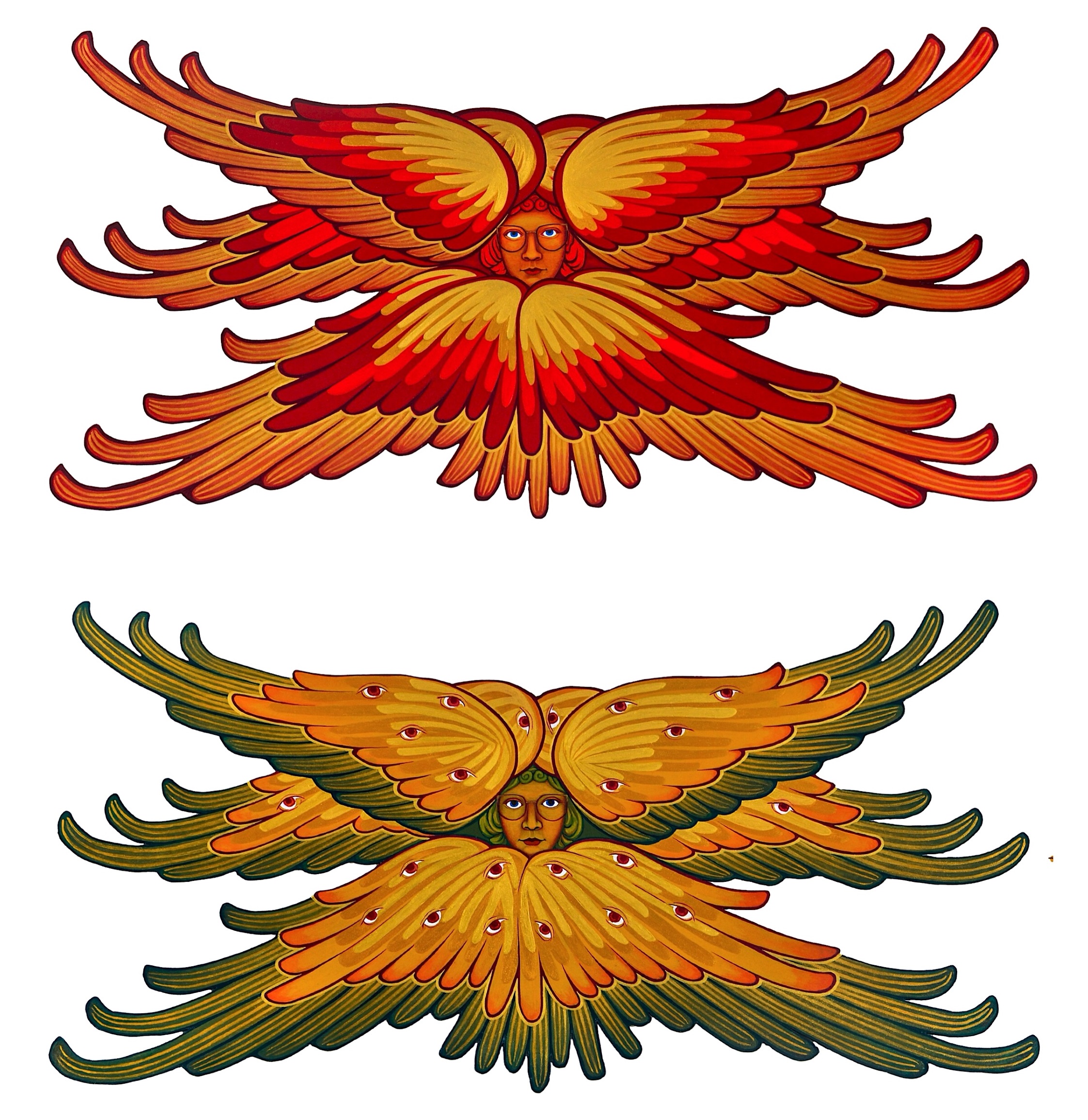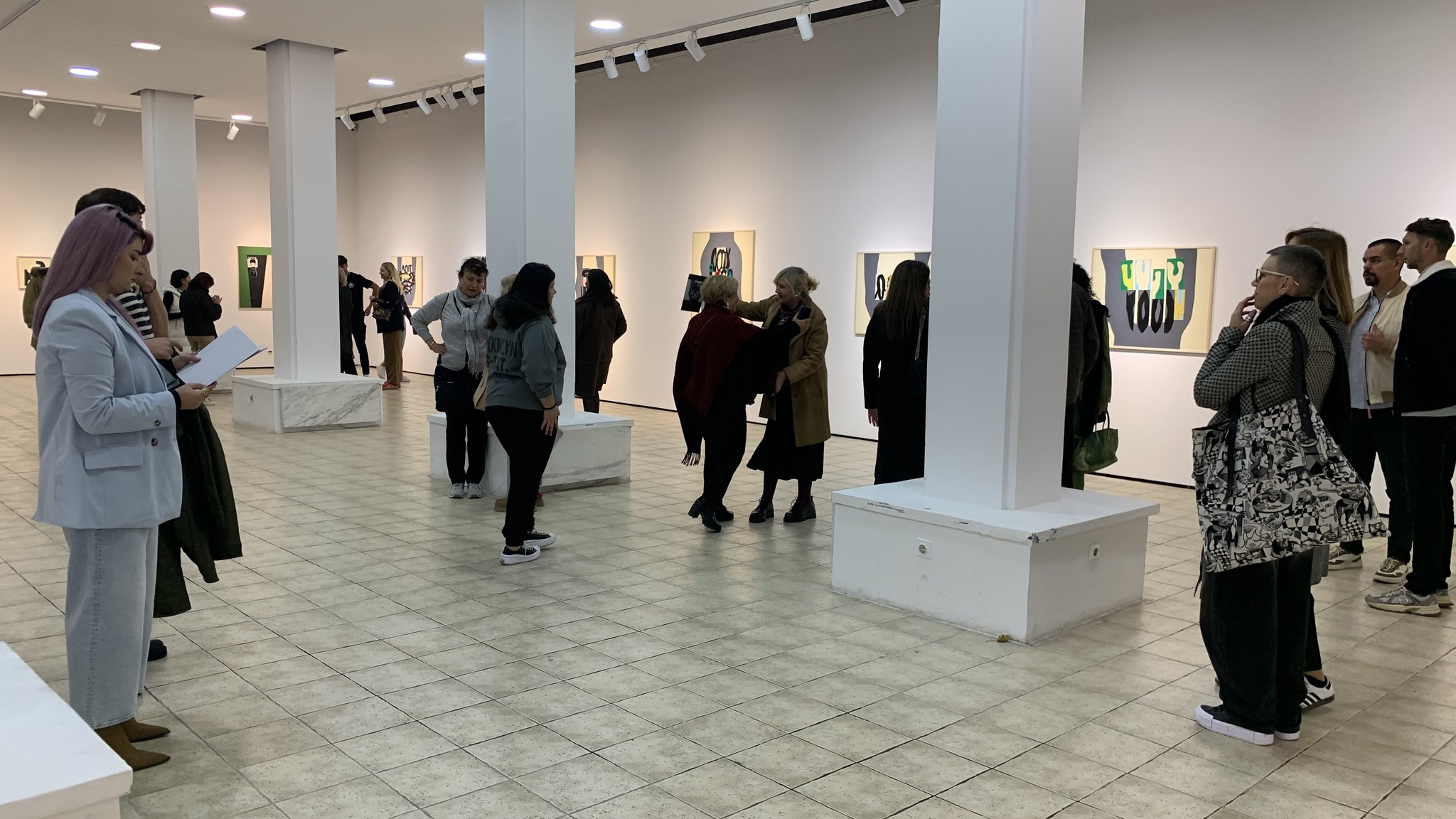АКТУЕЛНО
EXHIBITION OF PAINTINGS AND PROMOTION OF THE MONOGRAPH "MIROSLAV ANĐELKOVIĆ"
OFFICERS' HOUSING
We invite you to the opening of the painting exhibition and promotion of the monograph "Miroslav Anđelković" by Sonja Vukašinović, on April 10, 2025 at the Oficirski Dom Gallery, starting at 7 p.m. The promotion of the monograph will be attended by Emilija Ćoćić Bilić, director of the SLU Gallery Niš, Malina Radonjić, art historian, Sonja Vukašinović, museum advisor from the Gallery of Contemporary Fine Arts Niš.
The retrospective exhibition - in memoriam of Miroslav Anđelković consists of a selection of about forty paintings from his rich legacy as well as a selection of works from the Fund of the Gallery of Contemporary Fine Arts Niš.
Miroslav Anđelković was born on April 6, 1945 in Jelasnica. After graduating from art school in Niš, he enrolled at the Academy of Fine Arts in Belgrade. He graduated and received his master's degree in the class of Prof. Nedeljko Gvozdenović. He became a member of ULUS, Lada, and the Niš Graphic Circle.
Miroslav Anđelković entered the art scene in Serbia in 1970 with the exhibition "Generation 1969/70" and was noticed by art critics and professional audiences. He exhibited his work about 35 times and was awarded 11 times for his work. Abroad, he exhibited in group exhibitions in Luxembourg, Paris, Zurich, Basel, Lucerne, Aarau, Craiova, Veliko Tarnovo, Moscow, and Nitra.
He collaborated with prominent writers and poets from Niš. He provided drawings for many literary works, such as "People of God" by Bora Sranković, "Ibis Age" by Stevan Sremac, "White Stone" by Dragoljub Janković, Lyrical folk songs of the Timok region "Oh, how the old mountain", "Divinska Mycenae" by Radmilo Radovanović, while with Tomislav Mijović he published four books of a joint poetic-lyrical diary under the titles: "In the gentleness and solitude", "Shimmers of calling", "Javke odsjaji, ugarci", "Vreme na okupu", and he illustrated Stevan Raičković's work "Notes about Black Vladimir".
He began his working life as a professor, first at the Gymnasium in Leskovac and Niš, and then moved to the Gallery of Contemporary Fine Arts in Niš, first as a curator, artistic director and director. He then moved to the Faculty of Applied Arts in Belgrade, where he worked until his retirement as a full professor. In 2011, he was awarded the Grand Plaque with the Charter of the University of Belgrade. He participated in a large number of collective exhibitions in the country and abroad.
He passed away on April 15, 2021.
During his lifetime, he created over 400 paintings and countless drawings, watercolors, and graphics. The exact number is impossible to determine because the paintings have been stolen and a large number have remained in the permanent ownership of many institutions, museums, and galleries that have purchased his work or received it as a gift through participation in various art events and art colonies. His drawings adorn and illustrate many literary works. The family legacy includes 80 paintings and countless drawings and watercolors. Almost all of his work has been published in catalogues accompanying his solo and group exhibitions, and he has exhibited continuously for the past fifty years.
The development of his work has been accompanied by constant improvement and development without sudden leaps or drastic changes. The variety of colors changed depending on personal affinity and life circumstances, with the unlimited introduction of his emotional states and philosophical thoughts. Anđelković is inspired by nature, which he transposes. The paintings are dominated by a sensitively skillful harmony of the rational and the emotional, rich chromatic textures and visual parts, tonally harmonized with accents of warm and cold. His works exude strong emotion, which is presented through color but also strong expressive drawing.
Anđelković was one of the most attractive and versatile artists of Niš from the late twentieth and early twenty-first centuries in Niš and Serbia. Through his active engagement at all levels of culture, he participated in the creation of the city's artistic and cultural life.
He exhibited his work 35 times, winning 11 awards. He participated in many famous art colonies in the former Yugoslavia.
Throughout his working life, he worked on the promotion and creation of the city's artistic life, as an academic artist, artistic director and later director of the Gallery of Contemporary Fine Arts Niš, but also through various juries, commissions, artistic councils, pedagogical work, following his artistic credo in the hope of achieving his goal. His work will remain permanently recorded and remembered not only in these areas but also beyond, because he left a deep mark in the history of artistic creation in our country.
FEMALE ARTISTS OF NIS - A SELECTION OF WORKS FROM THE COLLECTION OF THE SLU GALLERY NIS
FINE ARTISTS OF NIS - A SELECTION OF WORKS FROM THE COLLECTION OF THE SLU GALLERY OF NIS
MMC Gallery Novi Pazar, April 4 - 18, 2025
Since its founding in 1970, the Gallery of Contemporary Fine Arts Niš has been dedicated to nurturing contemporary creativity, and thanks to the careful collection, preservation, protection, study and presentation of works of domestic and foreign art, the institution today has a valuable collection of around two thousand exhibits in the visual, aesthetic and historical sense, classified into five collections. A significant part of the fund are the works of fine artists from Niš, which provide insight into the trends and multi-layered changes in the visual scene of this region, and are the subject of study by curators, so far based mainly on analysis in the thematic - motif or stylistic - media sense. This Collection includes one hundred works by forty artists of different generations, styles and artistic practices, who live and create or are connected to this region by origin or work biography. The collection is enriched with these exhibits, the city's precious cultural heritage, gifts and purchases from solo or collective exhibitions and the participation of authors in residency programs, convocations of the Sićevo Art Colony and the Graphic Workshop.
Dealing with this topic was encouraged by the intention to point out the valuable contribution of Niš's female artists over the last five decades, but also by the personality, work and social engagement of Nadežda Petrović, the famous painter who 120 years ago founded the First Yugoslav Art Colony in the village of Sićevo, not far from Niš, the forerunner of today's Sićevo Art Colony.
From the very beginning, the gallery has strived to follow and support the work of artists of different ages, from the very young, through artistically formed representatives of the middle generation, to already established, prominent protagonists with rich careers, members of the Association of Fine Artists of Serbia (ULUS), winners of awards and significant recognitions for their work. Some of them studied or advanced abroad, achieved significant results in international settings, and a certain number of them are dedicated to pedagogical work at the Faculty of Arts, the Art School or in related educational institutions.
The works of Niš female artists represented in the GSLU collection have so far been exhibited mostly individually, at solo or collective exhibitions, published in catalogs or monographs, but never presented as a whole. Heterogeneous in visual expression, approaches and reflections, within a given chronological framework, they depict movements in the art of southeastern Serbia, the openness of the environment to new phenomena and contemporary aspirations and as such provide the possibility of comparison in a local and wider context.
Whether they expressed their emotions, inner feelings and experiences of the world around them through the medium of graphics, painting or combining materials, the motif of nature prevails in their works, which can be attributed to the fact that most of them were created during their stay in the colony. The painters, like Nadežda Petrović, enjoyed the freedom of creation under the open sky, and, unrestricted in terms of themes and motifs, consistent with their own artistic vocabulary and poetics, they transferred their visual sensations and impressions of the environment to the canvas. In addition to the Sićevo landscape, the gorge through which the Nišava River flows, rocks, mountain ranges and rich vegetation, they have woven into their works the impressions of their stay, the atmosphere of working in the colony, visiting the monastery and its surroundings, the acquaintances they made and socializing with the hospitable inhabitants. The artists were also inspired by the characteristic architecture of Sićevo, the village houses, and the life of people in rural and sparsely populated areas. In recent years, the participants of the Graphic Workshop have enriched the collection with interesting observations and new, current content.
The authors also recognized the starting point for their artistic research in the dialogue with the past and the rich cultural and historical heritage of this region. Relying on the traditions of medieval painting and the spiritual heritage of Byzantium, reducing visual elements to symbols or signs, giving them sublime, spiritual meanings, they created a special visual expression that seems spatially and temporally boundless.
Some artists, inspired by delicate creative energy and a constant need for novelty in their work and experimentation with materials, transformed their recognizable poetics into highly abstract compositions of simple, clean, systematically shaped surfaces and minimalist lines, leaving the viewer with the opportunity for emotional identification, analysis of inner worlds and the formation of irrational spaces.
Building their professional identity, the authors remained faithful to the medium of painting, drawing and graphics, while interest in sculpture is noticeable in a very small number of artists, mostly up to the year 2000. In three-dimensional shaping, they cultivated a complex, figurative approach, built classical, anatomical forms with specific processing of materials and gradually, in accordance with the trends of the time, introduced modern expression into their artistic practice. Unfortunately, in the last two decades, the collection has not been enriched with new works by female sculptors.
Taking into account the current moment, the possibilities of modern technologies and the influence of scientific achievements in the field of artyou, and contact and exchange with other cultural spaces, it is realistic to expect that Niš female artists will soon step into the world of new media, and that subsequent analyses and presentations will also include such types of research.
The exhibition at the MMC Gallery is an opportunity for the audience in Novi Pazar, based on a selection of works, to get acquainted with the creativity, individual development path of Niš female artists and gain insight into the city's art scene. With the narratives, poetics and approaches represented, it depicts diversity and presents them as active actors, who are stimulated by intense events and changes in visual art, with the undoubted influence of heritage and tradition, while remaining consistent with their artistic style and vocabulary, and are open to new knowledge, the influence of contemporary trends and tendencies. Compared to the number of male painters, graphic artists, and sculptors, there is a small number of academically educated female artists who have created in this environment, but taking into account the multiple roles of women in society and life in general, along with the need for self-realization, we must emphasize that their contribution to the cultural sphere is valuable.
It is encouraging that interest in fine arts as a future calling is increasingly present, and that this environment every year gives birth to new generations of young female authors, whose works and engagement will one day, as part of the GSLU collection, encouraged by this, be the subject of new reflections and studies.
Emilija Ćoćić Bilić
NENAD NEDELJKOV ''Study II''
NENAD NEDELJKOV
Study II
paintings and video
On Thursday, March 13, at 7 p.m., the exhibition of paintings and videos Studio II by Nenad Nedeljkov will open.
Nenad Nedeljkov's various conceptual and thematic interests are determined by his current artistic moment on the human figure and the possibility that the motif of the body responds to the desire for the visibility of the incorporeal. Therefore, on the basis of being and the body, a contribution is made to the eternal unraveling of the universal order, in the context of perishability and inexorable finality, and spiritual imperishability and biological vitality.
In an exceptional interweaving of digital and manual formative procedures, the artist creates variations of one and the same motif. A centrally composed cutout of a figure, with outstretched arms as in a crucifixion, is anatomically and graphically defined or almost completely distorted or reduced.
The two-channel video work Studio II is directly based on the cycle of variations in mixed media, entitled Studio, and represents its very successful extension, while the video Outside the Area suggests the flow of time and the cosmic rule of continuous movement.
Nenad Nedeljkov was born in 1971 in Zrenjanin. He graduated in painting from the Academy of Arts in Novi Sad. He received his master's degree in digital art from the Interdisciplinary Studies Department of the University of Arts in Belgrade. He has realized 15 solo exhibitions and participated in a large number of collective exhibitions in the country and abroad (the Netherlands, Montenegro, Bosnia and Herzegovina, Austria, Germany, USA, India, Australia, Turkey, Italy, Colombia, Great Britain, Switzerland, Greece, Mexico, France, Portugal, Argentina, Japan, Peru, the Netherlands).
The exhibition of works by Nenad Nedeljkov can be visited by the public in Niš until March 30th, at the Pavilion in the Fortress.
ACQUISITIONS 2015-2023
ACQUISITIONS 2015-2023 / PURCHASES OF PAINTINGS AND SCULPTURES.
In its fifty-five years of existence, the Gallery of Contemporary Fine Arts Niš has, thanks to various types of acquisitions (purchases, gifts, Art Colony "Sićevo", Graphic Workshop "Sićevo"), formed an impressive fund that currently numbers 1,798 works of art, classified into six collections. Since purchase is the safest and most relevant method of acquisition from the point of view of the value of a work, during the first twenty years of its existence, the Niš Gallery purchased works from numerous exhibitions for its collections, but this process was forcibly interrupted in the early 1990s, with the closure of the city and republic funds for the purchase of works of art due to the deteriorating economic situation in the country. After a long break, the Ministry of Culture of the Republic of Serbia began to announce annual competitions for “financing works of art for the needs of art gallery and museum collections” in 2014. Regularly participating in these competitions, GSLU Niš has purchased 61 works with the funds of the Ministry of Culture, including 2023, including 22 paintings, 16 sculptures, 15 works of new media and 8 works on paper. Since eleven works purchased in 2014 were exhibited at the previous exhibition Acquisitions, on this occasion we are presenting to the public for the first time all the paintings and sculptures purchased in the period from 2015 to 2023.
The exhibition consists of paintings by: Mihael Milunović, Nikola Džaf, Miško Pavlović, Bratislava Basic, Nikola Marković, Pulai Arpad, Ivan Šuletić, Vesna Knežević, Jadranka Mišić Pejović, Ivan Milenković, Srđan Đile Marković, Tadija Janičić, Igor Antic, the DIMTIM group, as well as sculptures by: Mrđan Bajić, Željka Momirov, Gabriel Glid, Dragan Drobljak, Rajko Popivoda, Gordana Kaljalović Odanović, Zdravko Joksimović, Dragan Jelenković, Marko Crnobrnja, Nikola Pešić, Dragoslav Krnajski, Radoš Antonijević, Balša Rajčević, Rade Mutapović and Anđela Grabež. All the purchased works possess high aesthetic and artistic regularity, they typically characterize the individual artistic handwriting of the artist, testify to the dominant motif-thematic preoccupation of the author and to the authentic visual expression. Most of the works contain clear echoes of general social circumstances at their semantic level and represent the author's intellectualized reaction to the characteristics of the current time, expressed in a metaphorical or symbolic manner.
The purchase policy of the GSLU Niš is continuously based on respecting several important principles, namely: unifying the exhibition and museological activities of the institution, adequate monitoring of the national scene, filling the collections with works by artists who are not represented in them or are insufficiently represented. Thanks to the purchases made, the collections of contemporary painting and contemporary sculpture have been significantly enriched with valuable works, the vast majority of which were exhibited in Niš, the number of authors represented in the GSLU Niš fund has increased, and most importantly - the purchases made have significantly contributed to the development of these collections, not only from the point of view of quantitative replenishment, but primarily from the point of view of increasing their overall qualitative value and updating. The exhibition will run until April 6.
STRUCTURES – NIŠ DRAWING 2024
STRUCTURES – DRAWING FROM NISH 2024 STRUCTURES – DRAWING FROM NISH 2024
December 17, 2024 - February 15, 2025
The first exhibition dedicated to drawing as an independent art discipline was organized back in 1991 in the Pavilion of the Niš Fortress and for the next six years it gathered only Niš artists. At the beginning of the new millennium, after a short break, this exhibition grew into a large, significant annual event with a competitive character with a given theme, to which artists from all over Serbia applied. As it gained popularity and an increasing response, each subsequent one was juried.
A total of 94 authors from Niš and other cities in Serbia participated in this year's thirtieth edition, and according to the jury's selection, the exhibition will feature works by 51 authors.
The theme of the Niš Drawing is: STRUCTURES (lat-struete - to arrange, to create)
The figurative approach in fine art has been understood and built from nameless and abstract elements since ancient times. Many contemporary artists have built their aesthetics on the structure of a painting, sculpture, graphic sheet, contemporary drawing or even an installation. We can view structure in the true sense but also comprehensively. Life and social structures, structural orientations, biological structures, sexual structures, political structures, structures of the written word, structures of natural phenomena, structures in music, art, painting, can be terms for visualizing this at first glance simple expression.
The broad understanding of Structure has inspired a large number of Niš Drawing artists, so the works created on the aforementioned theme have been viewed from multiple angles. Most of them stuck to their already recognizable and authentic artistic, intellectual and visual identity, so the exhibition represented a multitude of different techniques and styles. Certainly, the diversity in the understanding of drawing requires a complex reading, drawing attention to the evolution of drawing as a media in the contemporary world of new technologies, which is why, in addition to classic drawing (on charcoal paper or pencil), digital drawing is also represented. While for some artists, the drawing is completely materialized, building a structure of form, color, line, surface. On this occasion, the artists, with their thematic determinants, draw the public's attention to modern man surrounded by globalization, increasing stratification, wars, drastic differences in material status and the struggle for existence. We must mention the influence of social networks on the everyday life of the younger population. The layering of digital media as well as their diverse content can be of great benefit but also harm to society in general. All of the above also affects the contemporary artist, providing him with greater perspectives and information. Therefore, with the abundance of technical possibilities and the creativity of our artists, the exhibition represents a true review of drawing disciplines, which can be divided into several artistic units.
The tradition of classical drawing made in the technique of charcoal, watercolor, graphite pencil and combined techniques in figurative representation is noticeable in Milica Antonijević, Jelena Aranđelović, Miljana Dimitrijević, Ana Cvejić, Anđela Micić, Bojan Otašević, Jovan Spasić, Ivan Perak, Vladimir Randjelović, Sofija Milovanović. With a multi-layered figurative composition performed in pencil and clear ink, Jelena Trajković Popivoda puts drawing on a higher level so that drawing, like life, becomes a game. Expression through nature and natural phenomena is present in the drawings of Biljana Vuković, Jelena Malikov, Slobodan Radojković, Đura Radonjić, Daniela Fulgosi, Tatjana Marticki, while, for example, Jelena Šalinić Terzić, with her monumental depiction of a rocky scene in a relief layered spread of color and line, emphasizes the dominance of nature over man.
The games of geometric shapes and forms, intertwined lines, and circles are dealt with by Vesna Zarev, Stevan Kitić, Danilo Paunović, Jasna Gulan Ruzić, Vladica Ristić, Radovan Stanojev, Milica Rajković, while Dejan Ristić, Tijana Miljković, Marta Pejčić, and Nataša Stanojev use the new possibilities of modern computer drawing and photography techniques.
Nikola Milanov, Anđela Mujčić, Teodora Nikolić, Nikola Marković, Ivana Savić Dragana Kuprešanin, each in their own individual expression, deal with the emotions of modern man caused by personal lived memories or global problems and society.
We observe segments from nature transposed through photography with the rusticity of natural stone in Boris Kandolf. Bratislav Bašić emphasizes the connection with the past of centuries-old culture, art and religion through the remains of our cultural heritage. Many other works realized in abstract representation through drawing, collage, embroidery on paper, canvas generate a broader perspective of understanding structure (Jovana Đorđević, Anica Radošević, Teodora Nikolić, Dominika Morariu). Stylized ornaments from folk handicrafts such as carpets, Nikola Radosavljević, by perforating white paper, wants to point out the equality of everyone in the world and call for truce and harmony. The drawing woven into the stone sculpture of Julija Dubavac takes us back to the ancient past of our ancestors and the drawings in the caves of Altamira, emphasizing the layered intellectual structure of man, that same modern being, the only evolutionary of all mammals on the planet.
Tamara Pešić renames the drawing a warning sign and an anxiety zone of modern society.
The Gallery of Contemporary Fine Arts Niš has been nurturing an exhibition named after its venue for more than three decades and is grateful to the authors who have responded positively to the given topic over the past years and whose works, each in their own unique way, have left their mark on the art of their time.
PLURAL STRATEGIES
EXHIBITION "PLURAL STRATEGIES" - SELECTION FROM THE COLLECTION OF CONTEMPORARY PAINTING OF THE GALLERY OF CONTEMPORARY FINE ART IN NIŠ
Pavilion and Fortress /December 12th at 1:00 PM/
After exhibitions in Novi Sad and Belgrade, the Gallery of Contemporary Fine Arts Niš is organizing an exhibition from its rich collection entitled "Plural Strategies".
The exhibition features 30 Serbian artists from the second half of the 20th century who, as leading figures of their time, left a deep mark on our art history: Mladen Srbinović, Stojan Ćelić, Mića Popović, Milan Konjović, Ivan Tabaković, Zoran Pavlović, Boža Ilić, Lazar Vujaklija, Ljubica Cuca Sokić, Bora Iljovski, Peđa Milosavljević, Olja Ivanjicki, Sinisa Vuković, Mihajlo Petrov, Stojan Trumić, Bojan Bem, Čedomir Krstić, Boško Petrović, Kosa Bokšan ...
During the seventh and eighth decades, in addition to the existence of a number of newly formed individual painting practices, several parallel currents were discernible, so that completely separate artistic languages and innovative artistic phenomena began to exist at the same time.
Different artistic practices in one artist's work lead to the dematerialization of the work of art, penetrating the essence of the visual language. At the same time, new cultural and artistic phenomena begin to deal with existential questions, that is, critical reexaminations of reality. In addition, during that period, a group of artists appears on the Serbian art scene, expressing interest in the renewal of the figure in different contexts.
The selected works of art do not have a connection with the themes or ideas they explore, but as diverse visual achievements with completely individual problem concepts, they represent significant material for researching the development of visual art in these areas. Artists of various stylistic orientations, as representatives of complex artistic developments, participated in the formation of the collection of the Gallery of Contemporary Fine Arts, which today is among the most valuable collections in our country, aspiring to soon grow into the Museum of Southeast Serbia.
https://youtu.be/JPx8n8U4QUg?si=w2UqtvBpg59KJ-WN
Anđela Mujčić "Contemplation"
Anđela Mujčić
Contemplation
paintings, drawings, objects
Pavilion in Tvrđava
November 19 - December 10
Fifteen years of continuous presence on the domestic art scene and evident lexical, thematic and programmatic analogies and dichotomies in artistic work are the reasons for organizing a small retrospective exhibition of paintings, drawings and objects by Anđela Mujčić. Curiously, through the so-called small themes and humor, Anđela Mujčić first led her artistic work along the path of light nostalgia, and with a sense of the lovely and the likeable, then brought it to the field of social relations and latent activism, only to enter the field of spirituality and self-knowledge with her artistic maturation. We follow this developmental line through five cycles of works, a selection of which makes up the current exhibition "Contemplation". These are: "Eternal Game" (2008-2016), "Happy Place" (2016), "Women's Work" (2017-2024), "The Dream of a Funny Man" (2021-2022) and "Mother" (2024).
Anđela Mujčić was born in 1981 in Niš. She graduated in painting from the Faculty of Arts in Niš, specialized at the Faculty of Fine Arts in Belgrade, and received her doctorate from the Faculty of Art and Design in Belgrade. She is an assistant professor at the Department of Fine Arts at the Faculty of Arts in Kosovska Mitrovica, University of Priština.
She has held 25 solo exhibitions and participated in more than 150 collective exhibitions in the country and abroad. She participated in 28 art colonies and art camps in the country and abroad. She spent two months in residence in Paris at the Cite international des Arts, August-September 2016.
She was a member of the Expert Council for announcing the competition and selecting the project for the participation of the Republic of Serbia at the XXIII Triennale in Milan in 2022, under the title "Unknown Unknowns. An introduction to mysteries". She is the author of numerous workshops for students, children and youth and a participant in several international projects and forums.
She has won several awards for artistic work at national events. Her works are represented in several public and private art collections.
She has been a member of the painting section of ULUS since 2010 and ULUKiM since 2012.
https://youtu.be/3czi5vna9lI?si=e7_Ohf4GjyKR8OOW
9. NIS SALON 12/2
The exhibition includes works by twelve artists selected by two selectors. It is a traditional annual exhibition that the Gallery of Contemporary Art Niš has been organizing since 2017, with the intention of promoting cooperation, mobility and communication between artists, critics, institutions and the public. Given that each of the selectors independently and independently defines the concept of their project, the exhibition provides opportunities for dialogue and comparison of different critical discourses.
The selectors of this year's Salon are: Biljana Grković - art historian from Kruševac and Katarina Đorđević - master of painting from Niš.
Biljana Grković focuses her author's project on issues of current social reality, the characteristics of which are, among other things, determined by the concepts of biopower, biopolitics or necrotopics. Her selection includes works by the following artists: Biljana Đurđević, Vladimir Perić, Nataša Kokić, Nikola Radosavljević, Milica Dukić and Gabriel Glid. In the preface to the catalogue, Grković writes: “The selection of invited artists for this year’s edition of the Salon stems from the artistic practice of six artists, which is viewed within the broader context of the possibility of living a “good life” and the circumstances of the dominant forms of global capitalism and neoliberalism. The presented works are separate spaces in which, in different ways and in different media, the modes of the contemporary world are refracted and recognized – destruction, wars, ecological crisis, labor exploitation, the dominance of microdata, consumer culture, a world in which individuality, the individual who recognizes his or her identity, is disappearing. At the same time, they are also spaces that, from completely different artistic positions, immersed in the past or present, open new perspectives, create different worlds, restore hope in human dignity.”
Katarina Đorđević defined her author’s concept with questions that belong to the domain of art theory, apostorizing the characteristics of a work of art and the nature and mechanisms of its impact on the consumer or observer. In the preface to the catalogue, she writes, “The question of sensibility in the contemporary creative scene goes beyond aesthetic categorization – it is based on the induction of emotional responses that are reflected in the audience, encouraging them to engage in the basic thematic framework of the work of art, whereby its reading and experiencing is a dynamic experience that resonates on a personal and emotional level, rather than a mere passive adoption of the content offered.” Katarina Đorđević's selection includes works by the following artists: Aleksandar Dević, Slobodan Radojković, Petar Vujošević, Larisa Ackov, Mija Arsenijević and Lazar Šošević. Their selection is based on the characteristics that connect their work to "introspection as the main guide to creation, tactility, sensuality and sensitivity with which they build their artistic worlds, inviting us to immerse ourselves in and interpret hidden messages".
At the opening of the exhibition, the 9th Niš Salon Award for the most successful work will be presented.
A specially appointed three-member jury decides on the award.
The exhibition will run until December 14.
Biographies of the selectors
Biljana Grković graduated in Art History from the Faculty of Philosophy in Belgrade in 1986. Since 1987, she has been working as a curator at the Art Gallery in Kruševac, which was integrated with the National Museum in 1991. She works as an editor of the exhibition program and curator of the Art Gallery collection. She earned the title of museum advisor in 2010. She is the author of several monographic and retrospective exhibitions that have presented significant artistic opuses. She has been the curator of over 200 exhibitions. She is the conceptual creator and a member of the expert team of the art project Recognition, which has been international in nature since 2007. She publishes reviews and texts in the press, professional journals, collections and exhibition catalogs. She is a member of the Museum Society of Serbia, the Serbian Committee of the International Association of Art Critics AICA and the International Council of Museums ICOM.
Katarina Đorđević graduated and received her master's degree from the Faculty of Fine Arts in Belgrade. She is a full professor at the Faculty of Arts in Niš and vice-dean for international cooperation. She is a member of ULUS. She has studied in Austria and Italy. She has participated in more than 400 collective exhibitions in numerous European countries and in Iran, Canada, Japan, America, Korea. She has exhibited independently in many cities in Serbia and in Turkey, Iran, Bulgaria, Sweden, Italy, Bosnia and Herzegovina, Hungary, Spain, Great Britain. She is the recipient of the Charter of the University of Niš and the Faculty of Arts for her contribution to the development and promotion of these institutions, as well as numerous awards for her creative work in the country and abroad (Canada, Czech Republic, Poland).
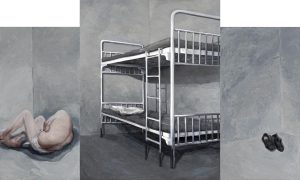
LIDIJA UZELAC'S EXHIBITION: "WHERE I AM"
LIDIJA UZELAC EXHIBITION: "WHERE I AM"
PAVILION IN THE FORTRESS 24 October - 10 November
As a curious artist who always strives for new, exploratory processes, Lidija Uzelac uses various visual techniques: paintings, drawings, canvas printing, layered collage fitting, installations, creating a fresh, innovative system.
Problematizing different ways of reading through enigmatic structures of action, in one part of her latest project she forms free, geometrized forms emphasizing the power of color and lines that possess a wide range of meanings, while in the other part she records her intimate states through a portrait of a Renaissance woman as a personification of mother, woman or matrix, alluding to the source and meaning of existence. Defining the flow of her own thoughts, memories and emotions, she skillfully combines materials to form narratives that relate to the phenomenon and essence of being.
Different levels of meaning invite deeper reflection on the relationship between image and space, reality and illusion, emphasizing elements of property in the current moment.
By arranging very carefully clean, systematically shaped geometrized surfaces and lines through a focused, intimate approach, she forms a complex visual language that functions in the coordinate system of personal symbolism.
Observing the painting process as a mechanism for reading the complex human nature, she expresses a clear personal stance, opposing the increasingly present loss of individual identity. In the title of the exhibition “WHERE I AM”, the artist seeks to establish contact with the viewer by drawing attention to the paradoxes of the contemporary social moment. In addition to abstract paintings and drawings, an independent entity is represented by a wall installation called: "Alma Mater", expressing her fascination with the portraits of women of the Renaissance masters, which remained recorded in her memory since the time of her studies in Florence, as an intriguing motif that for her represents a striking level of meaning related to nature, life, love, truth, wisdom, revealing the deeper truths of human existence.
Expressing a penchant for reduced forms, an analytical, layered approach and thoughtful compositional construction, Lidija Uzelac forms her own positions in the complex perception of the world and art.
Lidija Uzelac (1961. Travnik), graduated from the Academy of Fine Arts in Florence, Department of Painting, and then specialized at the Academy of Arts "Brera" in Milan. She completed her master's degree in the class of prof. Radomir Knežević at the Faculty of Arts in Banja Luka. She has organized 24 solo exhibitions in Pančevo, Pirot, Raška, Plovdiv, Smedrevska Palanka, Niš, Belgrade and over 50 group exhibitions in Serbia and abroad. She teaches at the Faculty of Arts in Niš as a full professor at the Department of Graphic Design in the subject of drawing and painting.
The exhibition will run until November 10.
Aleksandar Dević - retrospective exhibition
Retrospective exhibitions of paintings and prints by Aleksandar Dević, marking the artist's 45 years of creative work.
Aleksandar Dević (1954, Belgrade) graduated in 1978 from the Faculty of Applied Arts in Belgrade, where he also received his master's degree. For a short time, he worked as a professor at the Art School "Đorđe Krstić" in Niš and at the Faculty of Arts, participating in the formation of the Department of Applied Arts of this faculty. From 2000 to 2004, he was the director of the Gallery of Contemporary Fine Arts in Niš, where he also worked as a senior associate of the Internet Communications and Publishing Service and was the editor of the gallery's online magazine IIČ. He has had solo exhibitions in many cities in Serbia and in Greece (Volos), America (New York) and Hungary (Budapest). He has participated in more than 50 collective exhibitions in the country and abroad. He has been a member of the Painting Section of ULUS since 1986, as well as the Niš Graphic Circle. He has won several awards, including: the Redemption Award of the SIZ Culture, Belgrade; the Silver Plaque of ULUPUDS and the Special Recognition of the 45th International Festival of Documentary, Short and Animated Film, Belgrade.
In addition to painting, he also works in computer graphics and web design. His paintings and graphics are in private collections in Greece, Germany, the Netherlands, Denmark, America, and France.
With his decades-long oeuvre, Aleksandar Dević creates and perfects his own world of scenes and visions that are beyond the boundaries of rationalism and perceptual experiences, and under the auspices of imagination and fantasy, which makes him a significant successor to that line of development in our art that was started by Milena Pavlović Barili and Radoica Noe Živanović and applied by the members of Mediala.
From the very beginning, he cultivated a specific approach to figuration. In his earliest works, we can sense the influence of myth, legend, dreams... and in the artistic elaboration, a unique combination of archaism and modernism, rusticity and lyricism. The figure is not only the bearer of the plot, but also a witness and a factor of the ambience that is unusual, fanciful, created from differently treated segments and carries an aura of enigma and mystery. In doing so, Dević stepped into the realm of the surreal and metaphysical, which is the basic characteristic of the entirety of his oeuvre, although during the years of creation, changes occurred in the artistic expression itself, in the iconographic content and artistic structure. The nineties in Dević's oeuvre are marked mainly by graphics of wondrous coloristic harmonies, which exude esotericism and an atmosphere of illusoryness with a dominant impression of sophisticated visual art.
In the paintings created in the last twenty years, Aleksandar Dević has added new varieties and approaches to his artistic "legitimization". Occasionally, applying the principle of displaced quotation, he skillfully combined fragments from medieval or Renaissance art with motifs of different origins, creating dichotomously coded imaginary scenes. His latest paintings are full of some unusual dynamics, bravura "architectural" wonders, phantasmagoric machinery, a metaphysical atmosphere that includes a component of life but also a component of its diabolical destruction. The form is futuristically bold, robotic, disassembled and again assembled from a series of parts and details. Possessing a refined refinement towards semiotically complex symbols, he created a series of paintings of the same motif, which is a precedent in his previous artistic practice. Having skillfully and purposefully chosen the motif of the horse/rider, which has multi-layered meanings, mythological, theological, literary and artistic references (the Trojan Horse, the Holy Warriors, Don Quixote, the wooden horse of Dadaism...), Dević metaphorically raises awareness of various issues of a humanistic and ethical nature, because the time of shaken spirituality and growing technocracy requires a reexamination of existing criteria and values in all spheres, including the field of art. Breaking through the boundaries of the ordinary, Aleksandar Dević has created an opus that is extensive, authentic, meaningfully complex and enigmatic, and artistically precisely elaborated and refined. His works from the mid-19th century, which are a mixture of emotions and dreams, reality and reality, carry a latent mystery, enigma and metaphorical referentiality, making him one of the most original creators, certainly not only of the Niš but also of the national art scene.
The exhibition will run until November 10th.
https://youtu.be/VjD51G2J73o?si=iqO0YPpsVcmPh-MV
